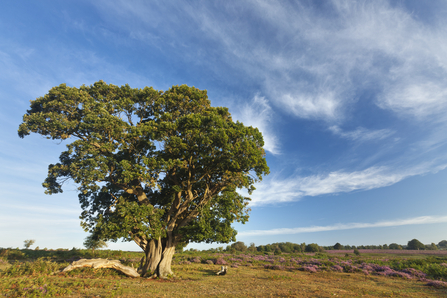All about galls
Cherry gall by NATT-at-NKM CC BY 2.0

Oak marble gall by Amy Lewis
What you think of as a gall may well be something like the oak marble pictured here with a hole showing that its occupier has left. But in fact there’s an amazing variety of growths that fall into the category of galls.
Galls appear on more than half of all plant families, and can appear on leaves, twigs, roots or flowers, fruits or seeds. They are all types of abnormal growth, but their appearance can vary widely. Galls forming on leaves include those of Harmandia globuli midges on aspen leaves and the sputnik galls of the Diplolepis nervosa wasp, found on wild roses.

Aspen gall by Mick E. Talbot (CC BY-NC-SA 2.0) and sputnik galls by Les Binns
Not all galls are marble-shaped growths on leaves. Robin’s pincushions, found on dog roses, are the gall of the wasp Diplolepis rosae. There are many chambers inside this feathery red growth, each containing a grub.
A gall wasp of the order Hymenoptera has caused a swelling in the tip of this alder twig to make a safe home for its larva.

Robin's pincushion by Amy Lewis and gall on alder twig by Vaughn Matthews

Nettle rust fungus by Janet Graham CC BY 2.0
Galls caused by fungus are different again. The rust fungus that grows on nettles is also a type of gall, caused by Puccinia urticata.

Ergot gall by Giles Watson CC BY-SA 2.0
The long, black gall caused by the fungus Claviceps purpurea is called ergot and occurs on the seeds of grasses, including rye and false oat. It is toxic to humans and commonly caused illness and hallucinations in medieval Europe, where a lot of rye was eaten. The disease was known as St Anthony’s Fire after St Anthony, who had terrible visions sent to him by the devil. The Order of St Anthony set up special hospitals for the disease – the first treatment was to exclude rye from the diet!

Witches' broom by Philip Goddard CC BY-NC 2.0
Witches’ brooms may look like tangled birds' nests but are in fact a type of gall. They can be caused by different microorganisms in different trees, for example the one in this birch tree is caused by the fungus Taphrina betulina. They are formed when a lateral bud loses control and causes multiple stems to grow in a tangle. The fungus can then feed on the shoots.
Gall formation
Gall causers cleverly manipulate the host plant to get what they want – either food, shelter or protection from predators. And they get it for free – it’s a parasitic relationship where the host gets no reward, although the galls do not usually harm the host plant.
Galls are caused by irritation or stimulation of plant cells, either by egg-laying or feeding insects, or by fungi. The exact process is still a mystery to science, but the result is that the host starts to reorganise its cells, causing the gall to form.

Cherry gall by NATT-at-NKM CC BY 2.0
Wasp galls, such as this cherry gall, are perhaps the most well studied. The process begins when the female wasp lays her egg in some part of the tree – the leaf, bud, catkin or even the roots, depending on the species. Either the eggs or the larvae then exude chemicals that cause the tree to create the perfect little habitat with a chamber (or chambers) for the wasp grub to grow in.
The larva itself can also stimulate the tree to direct more nutrients to the cells surrounding its chamber, providing a ready supply of food!
Gall wars
Galls are such comfortable and well-stocked homes that of course there is competition for tenancy. Many galls are effectively a kind of fortress for the occupants, and can be the site of fierce battles.
Many galls host lodgers called ‘inquilines’, many of which will live peacefully as a roommate alongside the original inhabitant in a separate chamber, although some grow in the same chamber and eventually smother the original tenant.
A bigger threat comes from parasitoid wasps which pierce the gall to lay their eggs within the larvae of gall inducers or inquilines. When the egg hatches it develops inside the host grub and devours it from within!
Of course the gall causers have developed tactics to resist this kind of attack. Many galls develop a hard outer layer with high concentrations of tannins to deter invaders. Others have complex outer surfaces with spikes or hairs, making it harder for an attacker to land.
In some galls, the chamber is buried deeply or protected by air pockets so that the attacker’s eggs can’t reach the larva. Other species simply invest in safety in numbers, with multiple larvae in multiple chambers – one of them is sure to survive!

Mature oak by Guy Edwardes/2020Vision
A world in an oak
Oak trees support more species than any other native tree in the UK. A mature oak can support around 280 species of insects, which in turn supply birds with an important food source. There’s a whole little world centred around this tree, and the many types of oak gall play a part in it.
There are hundreds of species of oak gall wasps, causing a huge variety of growths on oak trees - just four of them are pictured below.

Oak galls by M Chinery, British Gall Society and NATT-at-NKM (CC BY 2.0)
Add to these the species that invade the galls and compete for occupancy and the insect world is looking busy, but it doesn’t end there.
Great spotted woodpeckers are known to peck open tough galls to get at the tasty prize inside. Other predators include wood mice and birds including great tits. In autumn when spangle galls drop from oak leaves to the forest floor, wood pigeons will gather to feast on them. It’s all part of the cycle of life!





